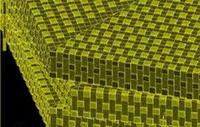-
New material for building thermonuclear fusion reactors

Two European projects – ITER and DEMO — propose development of fusion reactors that are economically viable; this work depends on the development of new structural materials capable of withstanding damage by irradiation and elevated temperatures resulting from the fusion reaction
-
-
Laws of traditional physics would foil Santa's effort to carry out mission
Santa has 31 hours to visit 378 million Christian children; at the rate of 3.5 children per household, and assuming at least one good child per home, this comes to 108 million homes; if each child receives no more than a medium sized Lego set (two pounds), the sleigh would be carrying more than 500 thousand tons, not counting Santa himself; Santa would thus need at least 360,000 Reindeer to pull the sleigh; since Santa must visit 108 million homes in 31 hours, he will have to travel at 650 miles per second — 3,000 times the speed of sound; at that speed, the lead pair of Reindeer would absorb 14.3 quintillion joules of energy per second each and vaporize — indeed, the entire Reindeer team would be vaporized within 4.26 thousandths of a second; Santa himself would be subjected to forces of 17,500 Gs; a 250 pound Santa (which seems ludicrously slim) would be pinned to the back of the sleigh by 4,315,015 pounds of force, and be crushed
-
-
String theory explains Santa Claus
Calculations maintain that the laws of physics should prevent Santa Claus from delivering all his gifts and that Santa would burn up in the atmosphere if he tried; the Norwegian Internet magazine, forskning.no, has put together a team of four top researchers to look into the case; the panel’s conclusion is clear: Santa can do the job and Christmas is saved!
-
-
Measuring the effect of fire on materials
Researchers at Universidad Carlos III de Madrid (UC3M) are developing an infrared measuring method to analyze the thermal properties and resistance to fire of composite materials; this advance would have applications in areas where fire safety requires that the composite materials withstand high temperatures
-
-
Improving pothole repairs
The alarming increase in the number of road potholes in the United Kingdom — an outcome of reduced road maintenance, increasing traffic volumes, heavier loads, and repeated adverse weather — is creating potentially hazardous driving conditions, causing serious concerns to the authorities as well as to the public; engineers are looking foe ways to improve pothole repairs
-
-
Scarce minerals, metals threaten manufacturing
The growing scarcity of certain minerals and metals is leading to explosive prices and delivery delays; since the relationships among these resources are strong, both the causes of and the solutions to scarcity are complex; for a manufacturing organization with a global supply chain, this can spell trouble
-
-
Making better, cleaner cement
Humans the world over use more water, by volume, than any other material; in second place, at more than seventeen billion tons consumed each year, comes concrete made with Portland cement; making cement, however, releases massive amounts of carbon dioxide; structural studies at Berkeley Lab’s Advanced Light Source could point to reduced carbon emissions and stronger cements
-
-
Chinese rare earth embargo would be “disastrous,” says mining executive
Mike Parnell, the CEO of U.S. Rare Earths, Inc., recently took the time to chat with Homeland Security NewsWire’s executive editor Eugene K. Chow; in the interview Parnell discusses the potential consequences of a full Chinese rare earth metal embargo, efforts to develop alternatives to rare earth metals, and the progress made in making the drilling process more environmentally friendly
-
-
Europe faces rare Earth metal shortages
The EU’s ambitious low-carbon energy production goal depends on five technologies: nuclear, solar, wind, bio-energy, and carbon capture; these technologies, in turn, depend on rare Earth metals; the EU estimates that a large-scale deployment of only one of these technologies — solar energy — will require half the current world supply of tellurium and 25 percent of the supply of indium
-
-
Mother-of-pearl inspires design of stronger materials

In nature, the strength of mother-of-pearl is a key to survival for some shellfish; researchers have offered an explanation for the unusual resilience – and they believes the findings could serve as a blueprint for engineering tough new materials in the laboratory
-
-
New tech could turn clothes into touch sensors
Everything from clothes and headphone wires to coffee tables could soon become interactive touch devices thanks to the development of new sensor technology; researchers at the University of Munich and the Hasso Plattner Institute are working to integrate technology originally designed to detect damaged underwater cables into touch sensors that can be installed in virtually anything
-
-
Printing a building -- additive manufacturing research moves into construction
Additive manufacturing — commonly known as 3-D printing — has been used for a surprisingly large range of products and projects, while the devices themselves have continually declined in cost and size; now the technology turns its attention to concrete and building
-
-
Large rare earth deposit discovered near California mine
Molycorp Minerals recently announced that it had discovered significant deposits of heavy rare earth minerals near its mine in Mountain Pass, California and production could begin in as little as two years
-
-
Electronic cotton: smart cloths made from conductive cotton fiber
The latest breakthrough in cotton fiber research may soon make possible hospital gowns that monitor medical patients and jerseys that test athletic performance
-
-
Formation of Senate and House rare Earth minerals caucuses urged
The Association for Rare Earth yesterday urged the creation of Senate and House caucuses to focus on the challenges of securing supplies of rare Earth elements for U.S. high technology, clean energy, and defense communities
-
- All
- Regional
- Water
- Biometrics
- Borders/Immig
- Business
- Cybersecurity
- Detection
- Disasters
- Government
- Infrastructure
- International
- Public health
- Public Safety
- Communication interoperabillity
- Emergency services
- Emergency medical services
- Fire
- First response
- IEDs
- Law Enforcement
- Law Enforcement Technology
- Military technology
- Nonlethal weapons
- Nuclear weapons
- Personal protection equipment
- Police
- Notification /alert systems
- Situational awareness
- Weapons systems
- Sci-Tech
- Sector Reports
- Surveillance
- Transportation
Advertising & Marketing: advertise@newswirepubs.com
Editorial: editor@newswirepubs.com
General: info@newswirepubs.com
2010-2011 © News Wire Publications, LLC News Wire Publications, LLC
220 Old Country Road | Suite 200 | Mineola | New York | 11501
Permissions and Policies
Editorial: editor@newswirepubs.com
General: info@newswirepubs.com
2010-2011 © News Wire Publications, LLC News Wire Publications, LLC
220 Old Country Road | Suite 200 | Mineola | New York | 11501
Permissions and Policies
